Rebuilding Puerto Rico’s Battered Farms
Air Date: Week of September 28, 2018
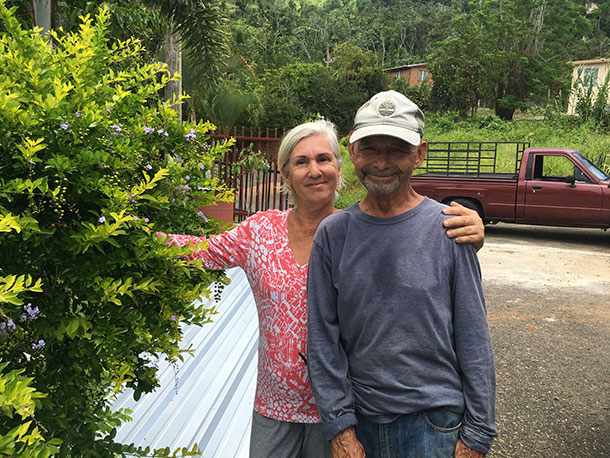
Farmers Domingo and Nilsa Romano are grateful for the physical and emotional support of the volunteers with the NGO El Departamento de la Comida. (Photo: Bobby Bascomb)
Despite being a lush tropical island, Puerto Rico imports nearly all of its food. Hurricane Maria brought road closures and shuttered grocery stores, leaving many Puerto Ricans with no choice but to skip meals and live on shelf stable and canned food for weeks and months. But as Living on Earth’s Bobby Bascomb reports, volunteers and farmers are working together to rebuild Puerto Rico’s small and devastated farming sector.
Transcript
CURWOOD: This week we continue our series looking at how Puerto Rico is recovering after Hurricane Maria laid waste to the island in September, 2017. We’ve looked at the resiliency of the corals, the forests, the drinking water system, and the people themselves. Now Living on Earth Bobby Bascomb checks in on the farming sector.
She went to Puerto Rico nine months after the storm and met some small farmers who lived through it and were still working to rebuild.
BASCOMB: Even before hurricane Maria uprooted trees and people, Puerto Rico imported roughly 85% of its food. After the storm that number shot up to about 95% imported food, if you could get it. Many people were forced to skip meals and eat shelf stable and canned food for months.
[MARKET SOUNDS]
Nine months after the storm one of the only places to find locally grown food on the island is farmer’s markets like the Saturday market in Rincon on Puerto Rico’s west coast.
MAN: Do you have kale?
CAROLO: Yes, we have kale. You want baby kale or dinosaur kale?
MAN: Dinosaur kale? How’s that?
Sonia Carlo’s nearby farm is slowly recovering from the storm. Today she’s brought pineapple, papaya, mushrooms, and the kale she’s explaining to a customer.
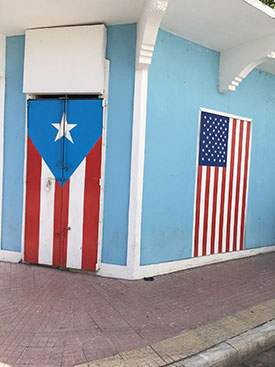
The Puerto Rican and American flags painted on the corner of a building in Rincon, Puerto Rico. The Puerto Rican dependence on imported food can be attributed, in part, to US economic incentives. (Photo: Bobby Bascomb)
CARLO: …. They’re two for five, so if you want both of them…
MAN: I like kale. What’s a single go for?
CARLO: Three, or two for five.
MAN: You got change?
CARLO: Yeah.
MAN: I’ll take…I’ll take both. Why not?
CARLO: Alright. One and one? Thank you.
BASCOMB: Sonia’s bright smile makes her a natural salesperson.
CARLO: It's a good time to be at the market right now.
BASCOMB: Sonia says things are just starting to turn around for her family and the farm. They are finally harvesting again and her farm to table restaurant, Sana, opened just a few weeks ago. But hurricane Maria was devastating for them. The storm destroyed her home. She had to send her 3 children to Florida to live with family while she and her husband, living in their car, rebuilt the battered farm.
CARLO: We got really trashed. All of our production for years of tropical trees like mango trees and passionfruit trees, they all died and they all were blown away. We had trees that were a hundred years old and you know, totally perished. Since the hurricane was a cyclone, it brought some salt water and some sand with it, so everything that was in its path, it looks like you threw herbicide.
BASCOMB: Across the island tall fruit trees were the most heavily damaged food crop. Root vegetables that could hide underground did ok. Ground plants like pineapples were among the first to recover and fast growing vegetables like salad greens were easy enough. After the hurricane visitors came to Puerto Rico with their suitcases full of seeds to donate to farmers. Sonia says they actually could have started growing again relatively quickly.
CARLO: But since we didn't have any electricity, we couldn't pump water out and we didn't have any gas, so we were unable to grow food because we don't have gas to pull out the water from the water pump. You know, it was just - you know trying to scrape up anything. Waiting ten hours for gas, just to grow food. It was very uncertain.
[SFX LATIN MUSIC IN GROCERY STORE]
BASCOMB: Grocery stores are open again on the island. But visit a grocery store on Puerto Rico and you’ll be hard pressed to find anything supplied by local farmers. I went shopping at an Amigo chain grocery store, which is owned by Walmart.
[SFX GROCERY STORE SOUNDS]
BASCOMB: Let’s see there’s pineapple from Costa Rica, coconuts from the Dominican Republic. Honeydew melon from Guatemala. Over here there’s more watermelon, chopped up – [gasp]. Aha! I found some watermelon from Puerto Rico. These are watermelon already cut up into pieces. The whole watermelon came from someplace else.
[GROCERY SOUNDS]
BASCOMB: To understand why this lush tropical island with year round sunshine and rain imports nearly all of its food you need to go back to the 1940s and a US initiative called Operation Bootstrap.
MARICHAL: With the colonization of the US there was a movement to get people out of their farms and into the cities.
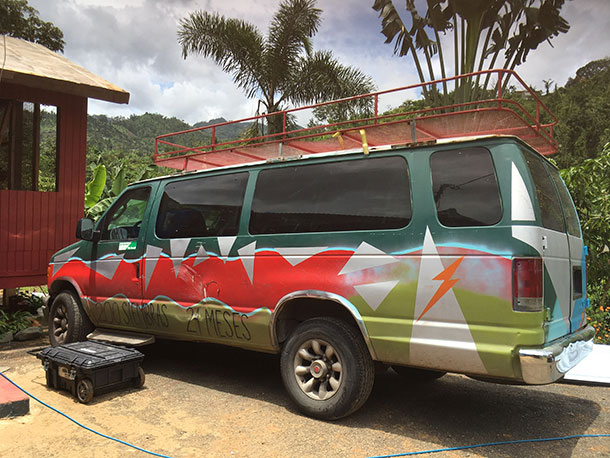
El Departamento de la Comida volunteers travel to farms in a bus, locally known as a guagua, which carries all the equipment they will need for their work. (Photo: Bobby Bascomb)
BASCOMB: Adnelly Marichal is the documentarian for the Resilience Fund in Puerto Rico. She says Operation Bootstrap transformed Puerto Rico from a largely agrarian economy to one based on manufacturing and tourism. They did that with a patchwork of government tax incentives and access to US markets. The farming that remained was not on the household level but on a larger, industrial scale.
MARICHAL: Now suddenly, it’s about making money so therefore you need to grow things like sugar and coffee and that’s great but those are not things that people can eat.
BASCOMB: And the food that is imported to Puerto Rico is on average 20% more expensive than in the US. That can be attributed at least in part to the Jones Act of 1920 which says any item imported to Puerto Rico must be carried on a US vessel. So, if Puerto Rico wants to import let’s say tomatoes from its neighbor, the Dominican Republic, those tomatoes must first go to the US mainland more than 800 miles away. They get put on a US boat, and then travel back those same 800 plus miles to Puerto Rico.
MARICHAL: So, it both makes the food more expensive and less nutritious by the time it gets here it’s been on a boat much longer than it has to be. It just creates a much longer timeline.
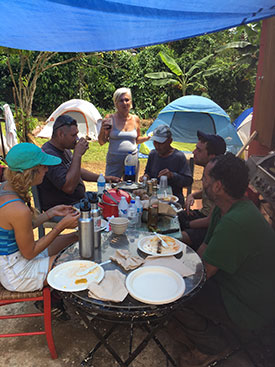
Volunteers eating lunch before they get back to work fixing the Romano’s roof. (Photo: Bobby Bascomb)
BASCOMB: One of the few agricultural areas of Puerto Rico is called Las Marias. The region is known for growing oranges for orange juice. I drove to Las Marias to meet with a small scale orange farmer.
[DRIVING SOUNDS]
Las Marias is way up in the mountains on the western half of the island. My drive is 13 miles but it took more than an hour on narrow, twisty, nausea inducing mountain roads. My GPS signal failed and I got wildly lost. It’s difficult to get here on a good day. After the hurricane it was impossible. Las Marias was cut off from the rest of the island for 2 months and had to have supplies airlifted in by helicopter.
[CHICKEN SOUNDS]
Farmer Dominogo Antonio Romano is 75 years old and has a small farm here with his wife, Nilsa. He walks past his chicken coop and stops in front of his only orange tree that survived the hurricane.
ROMANO: Only one, tenemous una sola.
BASCOMB: He used to have 20. Before the hurricane most of Domingo’s farm was made up of coffee, mango, and orange trees. The very crops most impacted by the storm.
DOMINGO: 90% of our farm was destroyed but it was really like 100% because with the hurricane no one could come here to harvest.
BASCOMB: Near the one surviving orange tree, amid debris of tree limbs and weeds, is a small patch of vining plants.
ROMANO: (SPANISH) This is a purple yam, they are very good.
BASCOMB: Root vegetables like yams were really the only food crops that didn’t get torn away by the 155 mile an hour winds of hurricane Maria. They were one of the only food crops the Romanos could still harvest and eat after the storm. But animals in the area were also struggling to find food. Wild pigs quickly discovered the purple yams and ate most of them.
ROMANO: (ENGLISH) Before Maria, we have many. But we have nothing.
BASCOMB: Domingo and his neighbors still had months to go before the roads would be cleared or the electricity restored. He says in that time they came to rely on each other for help.
ROMANO: Before Maria, there was forest everywhere. And then, after Maria, the trees came down and we could see our neighbors and we got to know each other. After the hurricane, there was a lot of empathy between the people, and everybody helped each other. And the bees! We got to feed them. After the hurricane there were no flowers so we put out sugar water for them.
BASCOMB: His crops were destroyed and roof torn off his house. They were without running water or electricity for months. Domingo says it would have been impossible for him to rebuild alone. But he’s not alone.
[CONSTRUCTION SOUNDS]
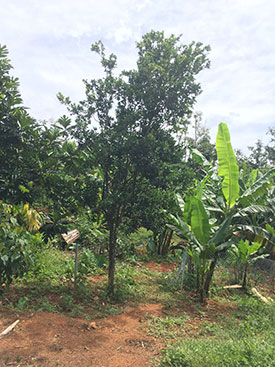
The Romano’s one remaining orange tree. (Photo: Bobby Bascomb)
5 volunteers from a grassroots non-profit group called El Departamento de la Comida, the Food Department, are here to camp out on the farm for a week and do any work that needs to be done: clear land, plant crops, fix fences and repair the roof.
[CONSTRUCTION SOUNDS]
The volunteer Food Department is organized into groups called brigades and are dispatched all over the island. As many as 20 people at a time descend on a farm for a week bringing with them seeds, tools, building supplies, and the man power to get a farm back up and running. Edan Freytes is the leader of this brigade. He says they do this work because farmers are crucial for Puerto Rico going forward.
FREYTES: the farmer is the… the agriculture is like the espina.
BASCOMB: The backbone.
FREYTES: The backbone of the country. And it’s the most damaged sector. I think it’s the sector we need more to help, because it got the worse loss.
[COOKING SOUNDS]
BASCOMB: Farmer Domingo’s wife, Nilsa, is in the kitchen cooking lunch for the volunteers… cassava root, sliced tomatoes, rice and beans. She lifts the top off a pot of soup she’s been working on since this morning.
(SPANISH)
N. ROMANO: This has pork, bread fruit, green banana, onion, pepper, cilantro, garlic.
BASCOMB: Nilsa says she’s happy to have the volunteers here. The work they are doing in a week would have taken her and her husband months. But beyond the physical help she is grateful for the emotional support and encouragement the volunteers bring.
DOMINGO: It’s very emotional for me because I was very depressed. It was a very traumatic experience. For months we were without water, electricity and a roof. And we were alone. With this group here I’m just so grateful for the support. So grateful.
BASCOMB: The volunteer Food Department has set a goal to send brigades like this to 200 farms across Puerto Rico, large and small, organic and commercial. They simply want to support domestic agriculture in any form.
[MARKET SOUNDS]
Sonia Carlo from the Rincon Farmer’s market says she had similar support, not from an organized group but friends, neighbors, and strangers volunteering their time to help her rebuild.
CARLO: What really got us through everything was the community. This, you know, we had a commitment to our community especially in Rincon people just said “what do you need, I’ll help you. What do you need, you need hands?” And we said “yeah, we need people.” “I’ll help you”. You know, and that gave us strength to keep growing and producing.
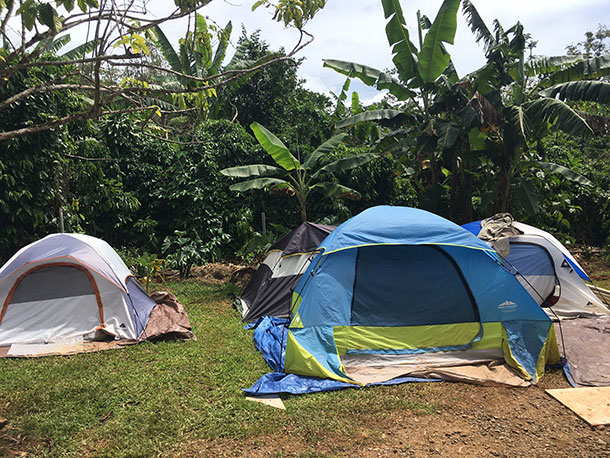
Volunteers with El Departamento de la Comida camp out in tents on a farm for up to a week to help farmers rebuild their farms. (Photo: Bobby Bascomb)
BASCOMB: And Sonia says that outpouring of support has given her a new sense of purpose to keep on farming.
CARLO: Granted, you see me standing here, I'm working seven days a week. But I'm doing it with a smile on my face, because I know it's for good. You know, it's for the good of everything. And I know this is my journey in life and this is what we're going to be doing. No matter how many hurricanes come, we’ll still bounce back. Nothing is going to keep me out. Not even a category 5 hurricane.
BASCOMB: For Living on Earth, I’m Bobby Bascomb in Rincon Puerto Rico.
Links
Living on Earth wants to hear from you!
Living on Earth
62 Calef Highway, Suite 212
Lee, NH 03861
Telephone: 617-287-4121
E-mail: comments@loe.org
Newsletter [Click here]
Donate to Living on Earth!
Living on Earth is an independent media program and relies entirely on contributions from listeners and institutions supporting public service. Please donate now to preserve an independent environmental voice.
NewsletterLiving on Earth offers a weekly delivery of the show's rundown to your mailbox. Sign up for our newsletter today!
 Sailors For The Sea: Be the change you want to sea.
Sailors For The Sea: Be the change you want to sea.
 The Grantham Foundation for the Protection of the Environment: Committed to protecting and improving the health of the global environment.
The Grantham Foundation for the Protection of the Environment: Committed to protecting and improving the health of the global environment.
 Contribute to Living on Earth and receive, as our gift to you, an archival print of one of Mark Seth Lender's extraordinary wildlife photographs. Follow the link to see Mark's current collection of photographs.
Contribute to Living on Earth and receive, as our gift to you, an archival print of one of Mark Seth Lender's extraordinary wildlife photographs. Follow the link to see Mark's current collection of photographs.
 Buy a signed copy of Mark Seth Lender's book Smeagull the Seagull & support Living on Earth
Buy a signed copy of Mark Seth Lender's book Smeagull the Seagull & support Living on Earth

